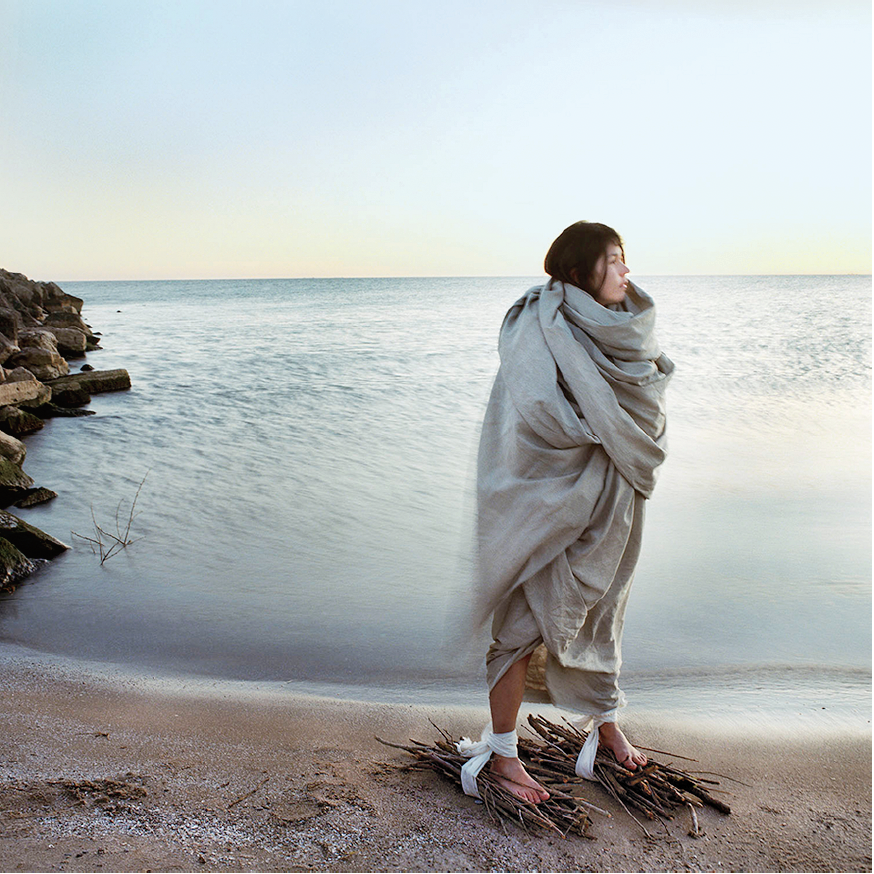Meryl McMaster
Meryl McMaster, long listed for the 2016 Sobey Art Award, is a rapidly emerging figure in Canadian contemporary art, whose works’ surreal likeness (or unlikeness) linger in the mind’s eye long after a first encounter. “Confluence,” the first survey of McMaster’s distinctively embodied and performative approach to photography, opened this spring at the Carleton University Art Gallery—the first of six installations that will travel across Canada until early 2018. Of Plains Cree, British, Dutch and Scottish ancestry, McMaster’s work is often discussed in terms of negotiation between her Indigenous and settler heritage. But although McMaster’s photography is undeniably founded on questions of selfhood, ancestry and identity, it is equally rooted in dreams, fictions and imaginings. Curated by Heather Anderson, “Confluence” brings together three bodies of work that expand the conversation around McMaster’s oeuvre to consider how she plays on identity as both a positive concept of becoming, and a potentially repressive responsibility.
In the six years since graduating from the Ontario College of Art and Design, McMaster has developed a rich and varied body of work, which blurs methodological boundaries between performance, sculpture and what is ultimately her photographic output. Although they are striking in their own right, McMaster does not consider her elaborate props—from dwarfing, bird’s nest-like headpieces to animal-like puppets and appendages— as stand-alone works of art. Rather, she imagines them as tools of personal transformation. The resulting photographs are, in many ways, self-portraits of that which is invisible or inaccessible to the self, capturing the tensions between cultural and personal memory and what is made possible by imagination.

Meryl McMaster, Time’s Gravity, 2015, ink jet print, 76.2 x 114.3 cm. All images courtesy the artist and Katzman Contemporary, Toronto.
In her series “Ancestral,” 2008–10, McMaster responded to a photographic absence of her immediate Cree ancestors by returning to the salvage-paradigm documentary work of photographers like Edward Curtis and Will Soule. By projecting 20thcentury portraits of Indigenous peoples over her own face and that of her father, McMaster reclaims and enlivens those who were supposed to have disappeared. Whereas in “Ancestral,” the artist transports the past into the present, in her series “In-Between Worlds, 2010–13, and “Wanderings,” 2015, she transports herself and audience into alternative fictional realities where the reclamation of ancestry is in tension with the self-determination of identity.
In its installation at the Carleton University Art Gallery, viewers first confronted McMaster’s Aphoristic Currents, 2013, a self-portrait of the artist wrapped in consecutive rings of twisted newspaper, her face painted white and dotted with black ink. The suffocating quality of the rings is offset by the hopeful words made visible by the artist’s constructions: “Damaged Souls, Trying to Heal, Learning to Survive;” “Remembrance;” “Stronger than ever.” The words, like the larger work itself, evoke both the possibilities and limitations associated with inherited pasts. Whether McMaster is buoyed or burdened by the rings and the harrowing past they suggest is ambiguous.
This tension and duality remain common themes in McMaster’s already rich oeuvre. Throughout the series “Wanderings,” she physically embodies the weight and responsibility associated with inherited identities, even as she imagines herself into different forms. In the work Equinoctial Line, 2015, McMaster carries an oversized spool of thread, its crimson tendrils wrapped around her body and trailing behind her in the snow. Whether the thread is a tether or an anchor to the past, to another world or to our own, is as equivocal as the artist’s spectral double-exposed presence in Desired Path, 2015, where the crimson thread continues its undisclosed trajectory.

Meryl McMaster, Viage, 2010, chromogenic print, 61 x 61 cm.
The piece Under the Infinite Sky, 2015, is perhaps the most telling of both McMaster’s technical expertise and intellectual approach. A collection of bowls with richly painted indigo interiors contrasts starkly with the white snow on which they sit and with the artist’s gently gesturing, crimson-coloured hand. Inspired by her travels in Peru, McMaster reinterprets the bowl-like stone carvings Incan stargazers filled with water to more comfortably view the night sky through its reflection. The seeming irrationality of the gesture— looking down in order to see up— finds its parallels in McMaster’s practice, wherein to understand her own identity and world, she creates new ones. As cheyanne turions writes in her catalogue essay “Close to Frostbite,” for McMaster’s first monograph, McMaster’s photographs are a “powerful articulation of identity along a spectrum of instantiation: from inherited to burgeoning to speculative.”
As Canada welcomes its sesquicentennial year—with the myriad celebrations, criticisms and challenges it will inevitably entail—Meryl McMaster’s adept articulations of self and identity fluctuating along a spectrum of history and imagination evoke the identity politics not only of self but also of nation(s). If “Confluence” is a junction and a site of merging, then Canada at 150 years postconfederation is at an important, speculative junction. One at which change and improved cooperation between its multiple identities is still possible—if only we can imagine our sometimes burden as a buoy instead. ❚
“Confluence” was exhibited at the Carleton University Art Gallery, Ottawa, from May 2 to August 28, 2016.
Manon Gaudet is a recent graduate with an MA in Art History from Carleton University. She currently works at the J Paul Getty Museum as a graduate intern in the exhibitions department and has previously held positions at the Metropolitan Museum of Art and the Smithsonian Institution.

